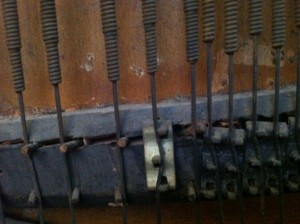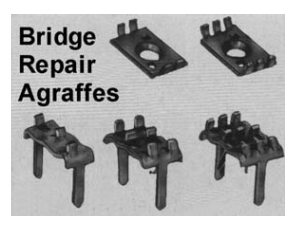Old pianos can be extremely challenging for any technician in the field (see my discussion about geriatric pianos in “The Life of a Piano“). Many of the problems are caused by dried, brittle wood or failing glue joints that have deteriorated to the point where they are no longer able to function as they were designed.
In extreme cases, as I’m about to describe, the failures are catastrophic and require careful consideration about the future and functionality of the piano.
The instrument I’m discussing here is a 1918 Knorr 52” upright piano (what they referred to as a “vertical grand”). As is often the case with pianos like it, the owner had acquired it through a series of hand-me-downs and it was intended to provide a platform for her young children’s piano lessons.
She was referred to me by a neighbor whom I had worked for a about a year earlier and she was aware that it had some issues. I was asked to tune it and evaluate its condition.
One of the first things I noticed, aside from it being ~75 cents flat and having severely rusted (or missing) strings and tuning pins, was that the bass strings were dead and buzzing.
I opened the bottom panel to see what was going on inside and found something quite remarkable (pictured left).
What you’re looking at here is a badly cracked bass bridge with some repair agraffes (that shiny thing in the middle and the not so shiny older ones to its right). I’d seen these things in parts catalogs but never installed in a piano so it was a new experience for me.
If you look at the top row of pins you’ll see the reason for the buzzing strings and why the agraffes were used; The split or crack in the bridge (the dark wooden part that the strings cross) along the line of pins that are supposed to angle away from each other and hold the string securely against the bridge so it can transfer its vibrations to the sound board (the brown panel at the back of the picture). The strings need to “dog-leg” across the pins. The top pin plays a critical role here because it provides the terminus for the string and thus determines its speaking length and what pitch it can produce when under tension.
The top pin on the string just to the left of the newer repair is standing straight up and is unable to hold the string against the bridge. The string to the left of that is on the wrong side of the lower pin so it too is just floating around on the bridge. You’ll also notice that the top bridge pin to the right of the newer repair agraffe is actually leaning to the right and completely disabled. These three strings have very pronounced buzzing and are incapable of producing a recognizable tone (kind of like shaking a can full of coins). The rest of the bass strings are so dead that it sounds like you’re kicking a flat tire.
What a mess!
The pictures below should give you an idea of what a bridge is supposed to look like and how the repair agraffe appears in its natural habitat (the catalog).
The piano’s owner has decided to live with it for the time being since she and her children are just beginning lessons and probably won’t be using that section of the piano for a while.
I, on the other hand, have found something wonderful to write about and am pleased to share the experience with all of you. I’m curious to know if any of you have seen this repair before.
Leave a comment and let me know I’m not alone.




Fascinating Jon, the extent of my piano knowledge is some keys are black and some keys are white. I’ve decided the insides are very complicated.
You’re correct, they are complicated. That’s why I write about it. I hope my efforts to expose the inner workings will help people appreciate what I do and the depth of knowledge and experience required to keep them functioning properly.
Love this, very detailed explanation of an obscure problem that most people would not understand or appreciate. The pictures really helped to illustrate what you’re talking about.
I know of the repair but have never done it. I tune lots and lots of circa 1900 pianos. Too many! At the moment, i have the action of an 1888 upright in my basement. It is a brass rail, which I know from the past is a BITCH to work on. This Action had 11 hammers loose. It also had a bizarre jack which I’ve never seen. It had a hook at the top, which fits into a slot in the butt. This repair was a nightmare! I did get it done, accompanied by much screaming and cursing. This is a luxury for me, as I do not vent in people’s houses.
Anyway, sorry for diverging. I guess it falls in the pianos older than God category.